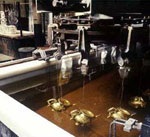Zinc Plating

Zinc plating is identical to electro-galvanizing in principle because both are electro-deposition processes. However, zinc plating is used on small parts such as fasteners, crank handles, springs and other hardware items ratherthan sheet metal. The zinc is applied as an expendable electrode in a cyanide, alkaline non-cyanide, or acid chloride salt solution. Cyanide baths are the most operationally efficient but can potentially create pollutionand are hazardous.
After alkaline or electrolytic cleaning, chemical cleaning to remove surface oxides, and rinsing, the parts are loaded into a barrel, rack, or drum and immersed in the plating solution. Various brightening agents may be added to the solution to add luster, but careful control is needed to ensure a quality product. Post-plating treatments may be used to passivate the zinc surface as well as impart various translucent colors or to extend the life of the coating.
Zinc plating is typically used for screws and other small fasteners, light switch plates, and various small parts that will be exposed in interior or mildly corrosive conditions. For use in moderate or severe environments,the materials must be chromate-conversion coated for additional corrosion protection.
Coating Characteristics
The normal zinc-plated coating is dull gray in color with a matte finish, although whiter, more lustrous coatings can be produced, depending on the process or agents added to the plating bath or through post-treatments. The coating is thin, ranging up to 1 mil (25 µm), restricting zinc-plated parts to very mild (indoor) exposures. ASTM Specification B 633 lists four classes of zinc plating: Fe/Zn 5, Fe/Zn 8, Fe/Zn 12 and Fe/Zn 25. The number indicates the coating thickness in microns (µm). The coating finds application in screws and other light fasteners, light switch plates and other small parts. Materials for use in moderate or severe applications must be chromate conversion coated. The coating is entirely pure zinc, which has a hardness about one-third to one-half that of most steels.
